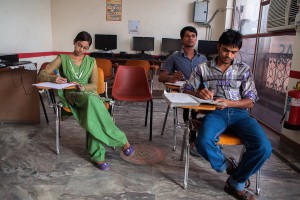Filling India’s huge need for vocational training
View(s):Ghaziabad, India — In a simple classroom above a storefront on a bustling street, four young men crowded around the colorful innards of an open computer hard drive while their teacher explained in Hindi how it all worked The computer repair course was among 25 offerings at Gras Academy, a private institution with 58 skills training centers across India, including this one in Ghaziabad, a city on the outskirts of New Delhi.
Gras is one of a burgeoning number of private academies providing hands-on job training in India, filling a gap between government vocational centres and four-year universities. These schools — which offer short, practical, nondegree programs — have been growing since the early 2000s.
India has a vast population of young people, with more than half of its population of 1.2 billion younger than 25. It faces the immense challenge of harnessing this generation as a productive work force, or else facing the combustible prospect of hundreds of millions of unemployed youth in the future. The Indian government estimates that 500 million young people must be trained by 2022 and has made skills training a major policy issue.
Inderjeet Singh, 19, is a first-year student at a government college; but attendance there is not mandatory, giving him time to attend Gras’s computer repair class. His college tuition is about 5,000 rupees, or less than $90, per year, but he is willing to pay 22,000 rupees for the six-month Gras course. He thinks it will be worth it, because 70 percent to 75 percent of Gras’s graduates find jobs immediately, according to the academy.
“I want practical knowledge from school,” he said. “Sometimes it is easier to understand practical knowledge, rather than theory.”
Since 2006, Gras has trained about 28,000 students in 10 Indian states. More than 60 percent take technical courses on computer networking, accounting, and computer and cellphone repair. Service industry training is popular for those who want work in shops, restaurants and hotels, as are courses for future plumbers, electricians and beauticians.
Kanchan Sharma, a slight 17-year-old, is taking a six-month accounting course at Gras, where she is one of 15 students in a room equipped with several computers. She is also in her first year of a college, where she is one of 50 students in a correspondence course that offers little practical training. Most government college accounting classes, including hers, do not teach the software that most Indian companies use.
“Here, classes are smaller and the quality of teachers is good,” she said of Gras. “Plus, what we are being taught is practical and linked to industry.”
She pays 18,000 rupees for the Gras course in hopes that it will result in a job that will help her support her family.

Kanchan Sharma, 17, left, took an English class at a Gras Academy branch. She says she learns more from the vocational school than she does from the traditional college where she is also enrolled.
While students like Mr. Singh and Ms. Sharma decided to take vocational classes on top of a more traditional college or university degree, many others come from far less educated backgrounds. At both Gras and Gram Tarang, another company that runs training centers, more than half of students are middle school dropouts. Many also need to learn basic life skills, like the importance of punctuality, speaking professionally with supervisors and keeping a tidy appearance.
“Training is just a bridge. The end is jobs and employability,” said Tahsin Zahid, founder and former chief executive of Gras Academy. “These kids are afraid. They’ve never been to a professional institution in their lives.”
Indian companies routinely complain about the dearth of employable workers. According to the 2011 Talent Shortage Survey by Manpower, a human resources company, nearly 70 percent of Indian employers had trouble hiring staff members.
In South Asia, many youth “leave school or university without skills that are demanded by employers,” the International Labor Organization said in a February report.
Industries that have boomed in the past decade, like telecommunications and retail, cannot find enough skilled workers for their rapid expansion. Some large companies, like Infosys andTata Consultancy Services, have their own in-house training centers.
Government vocational institutes were established in the late 1960s and thousands exist today. But the quality is patchy, and the curriculums and training are outdated. The World Bank estimates that India’s training institutes serve only about 7 percent of students who need vocational skills.
Inevitably, there have been comparisons with China, Asia’s other booming economic superpower. According to the Web site of Gram Tarang, India has only 11,000 vocational training schools, compared with China’s 500,000.
Gram Tarang is headquartered in Orissa, a poor eastern state whose main industries are mining, power and steel. It focuses on training fitters, machinists, mechanics and electricians, and places graduates in jobs both nearby and in large southern cities like Chennai and Bangalore. Since 2006, it has trained 28,000 rural young people. Abhinav Madan, managing director of Gram Tarang, said that a vocational education saved many from either unemployment or becoming target recruits for Maoist rebels who have waged an armed insurgency in poor, rural areas.
Gram Tarang is supported by the National Skills Development Corporation, which the Indian government started in 2009 to fund training centers and to act as a go-between with industry. It has the formidable target of training 150 million people by 2022.
The N.S.D.C. works with 71 skills institutes across India. At the end of January, its partners had trained 363,789 people in 27 states and territories. More than 70 percent of graduates found jobs.
Follow @timesonlinelk
comments powered by Disqus


